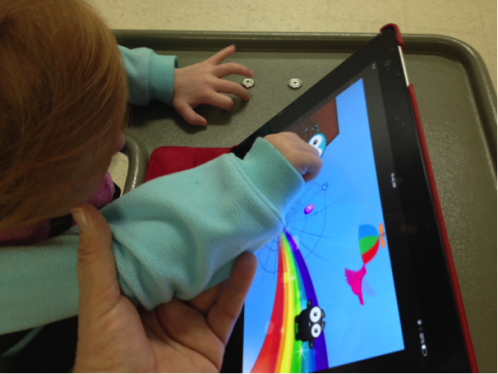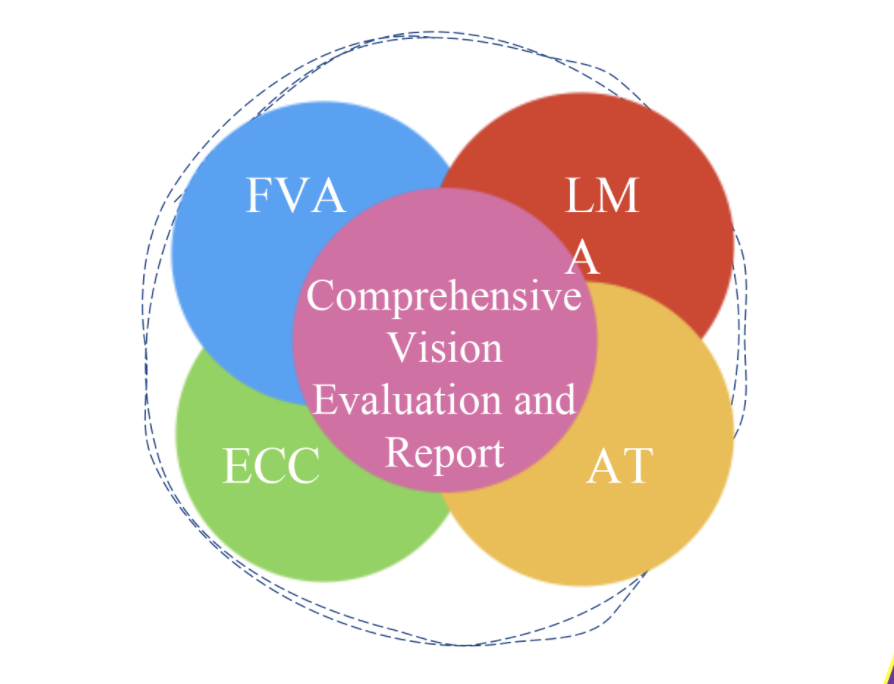Learning Media Assessment reports generally contain common elements, such as:
- Use of Sensory Channels
- Learning Media
- Literacy
- Literacy tools/technology inventory
- LMA Summary and Educational Implications
Below you will find samples of three different types of students, with descriptions under each of the main headings.
Use of Sensory Channels
STUDENT 1
Melody (progressive loss of vision) needs a great deal of extra time for visual tasks, and the following adaptations: Large print (at least 24 bold in a clear sanserif font such as Ariel); CCTV; ZoomText screen enlarging software; cane for off campus, unfamiliar or poorly lit travel; braille; talking dictionary and calculator. Melody uses visual, tactile and auditory channels for learning. She prefers visual learning, and will say, “I don’t care,” or request print when given a choice.
Melody reads braille text slightly more efficiently then she reads print but has not yet developed efficient braille reading. More regular use of braille would help, but currently she does not like to read braille and therefore is resistant to reading. At this time, she uses braille in her History class only and large print or listening in all of her other classes. She has some auditory texts, but does not read textbooks in any medium.
STUDENT 2
Mike (VI with an auditory processing problem) benefits from extra repetitions to process verbal material presented in any sensory channel. For example, when given an assignment, he will review the directions multiple times until he is sure he understands them. He then follows them accurately. To answer comprehension questions, he returns to the passage to reread the appropriate sections to find the answers to accurately answer the questions.
STUDENT 3
Bill (reluctant braille reader) uses his visual, tactile and auditory senses, but is primarily an auditory learner in acquiring academic information. It appears that his preferred sensory channel is visual because he most often tries to look at an object or person before using tactile skills, but his limited acuity requires him to gain most of his information through other modalities. He is learning to read uncontracted braille tactilely.
Learning Media
STUDENT 1
Melody uses print, braille and readers for her academic learning. She alternates between stating no preference at all to a strong preference for print. She will not request a braille copy. When prompted to choose, she either stated that she did not care or chose the print materials.
She enjoys using her vision when she can and wants to do so as long as she can. She has insisted on doing most of her schoolwork in print, using a reader when necessary. She does use braille for her History class. When math work is read to her, she writes relevant details herself with pencil and paper. If she doesn’t write details down she usually will forget them. Displaying a similar need to recall details, she independently returns to reread material in print or braille as she works math problems. In print reading she is hunched over and appears physically tense. Once she begins, she works steadily using either braille or large print materials.
It appears from observation of Melody’s work in class that she lacks efficiency in all channels. She read 28 wpm on one unfamiliar informational passage in braille, increasing her speed to 32 wpm on a reread. It is possible that she reads braille a little faster than this in her History class.
STUDENT 2
Mike’s current learning media is regular print, with no larger than 18 point font. He is learning braille but is not ready to use it as a primary learning media at this time. He uses repeated review and additional time to process verbal information.
STUDENT 3
Bill’s primary learning medium for reading is uncontracted braille. He shows much stronger comprehension and speed with auditory material, which he uses in his academic classes. He reads all of his braille letters in isolation at a rate of 75 per minute or more. In words and sentences, he has a tendency to reverse i/e, d/f, h/j and r/w. Bill is considerably faster in uncontracted braille, with many more reversals when using contractions. Bill’s reversals also create significant difficulties in reading numbers for math, so he does his math problems in print with a magnifier or a CCTV. He is learning print letters of the alphabet to be able to use them for algebra problems. When print letters were presented on flashcards, he consistently missed the letters d, h, m, and w. He recognized word parts such as ch, tion, th, ing, and st that he has learned to read in his reading class.
Literacy
STUDENT 1
Melody reads and writes in print and braille. She knows the literary braille code and is limited primarily by her low motivation and infrequent practice, which lead to lower fluency. Melody prefers print reading, but experiences significant visual fatigue after only a short time (15 minutes is max). Melody is beginning to recognize that braille is less taxing for reading long passages texts. She is also able to read both Nemeth code for mathematics and the braille code for Spanish texts at an instructional level.
STUDENT 2
Mike’s primary literacy medium is currently regular print, which is adequate for his needs at this time. He is expected to transition to braille in the future. On an informal reading inventory, he read print at 80 words per minute (wpm) orally at grade level with meaningful expression and greater than 90% accuracy. However, he only demonstrated a 20% comprehension rate. On material read to him, his comprehension levels are:
- Independent level auditory comprehension—3rd grade (95%)
- Instructional level auditory comprehension —4th grade (70%)
- Frustration level auditory comprehension —7th grade (30%)
When he reads the material himself, his comprehension levels are a grade or two higher. He demonstrated instructional/frustration level comprehension at the 6th grade level (70% accuracy) and 7th grade level (55% accuracy). Rereading the material himself or listening to it after reading it himself helps his comprehension.
STUDENT 3
Bill’s primary literacy medium is currently uncontracted braille.
Reading Scores on a Jerry John’s Informal Reading Inventory in September 2010 are as follows :
Uncontracted braille:
- Pre-Primer 2: 30 words per minute, 4 miscues, Instructional level decoding.
- Primer: 14 words per minute, 7 miscues, Frustration level decoding
- Comprehension: 1 question missed, Independent level comprehension
Listening Comprehension:
- Grade 5: 1 questions missed, Independent level comprehension (Since Bill and his family raise cattle, Bill knew a lot about the care of animals, which was the topic of this story).
- Grade 6: 3 questions missed, Instructional level comprehension
- Grade 7: 5 questions missed, Frustrational level comprehension
Literacy Tools/Technology Inventory
STUDENT 1
Melody uses a computer with extra large font with Zoom text.
STUDENT 2
Mike uses high contrast standard regular print textbooks and supplemental materials for his academic learning. He also uses braille instructional materials and the Perkins braillewriter for learning braille.
STUDENT 3
Bill uses uncontracted braille for reading instruction. In math, he uses large print books with his CCTV to view numeric problems; word problems and text information are read to him. He writes his math problems in large print with a 20/20 pen in approximately 1″ letters. Charts are helpful to him to organize and follow his computations. He gets most other content area material through auditory presentation or direct hands on experiences. He can write simple words and sentences of patterns and memorized words on a Perkins brailler or Braille Note. He is learning to use JAWS. He is practicing his keyboarding skills and can locate most letters, but needs to have most words spelled for him to be able to write material on the computer. Sometimes he uses a scribe to write down his answers, because it significantly increases his ability to demonstrate his learning.
LMA Summary and Educational Implications
STUDENT 1
Melody prefers learning visually, but also gains educational information tactilely and auditorially. This is shifting gradually over time from primarily visual to tactual as Melody becomes more willing to make the shift. Melody wants to continue using her vision as long as possible and strongly resists being pushed to braille, but gradually is making the change herself if not pressured into it. She has been using braille for most of the reading in History, some in English and most of the math review she has done in braille class. If it could be available without stress to use it, she might benefit from having the braille as least as readily available as print in her other classes as well.
STUDENT 2
Mike is a visual learner who is better at identifying words than answering comprehension questions about the passages. He understands more of what he reads visually than what he hears. A strength for Mike is that he is willing to review material until he understands it. He works diligently on learning braille skills, even though in good light he currently functions efficiently visually.
STUDENT 3
Bill uses all of his senses in his learning. He reads and works math problems visually. He uses both vision and tactile senses for discriminating real objects and manipulatives. His literacy medium is uncontracted braille, but he has significant difficulties in reading. A reading assessment is currently underway. Currently, he gains most of his academic information auditorially.
In math, Bill primarily uses print to read numbers, math symbols and some letters in equations. He uses both vision and touch for discriminating real objects and manipulatives. For word problems, he has someone read the math problem verbally.



